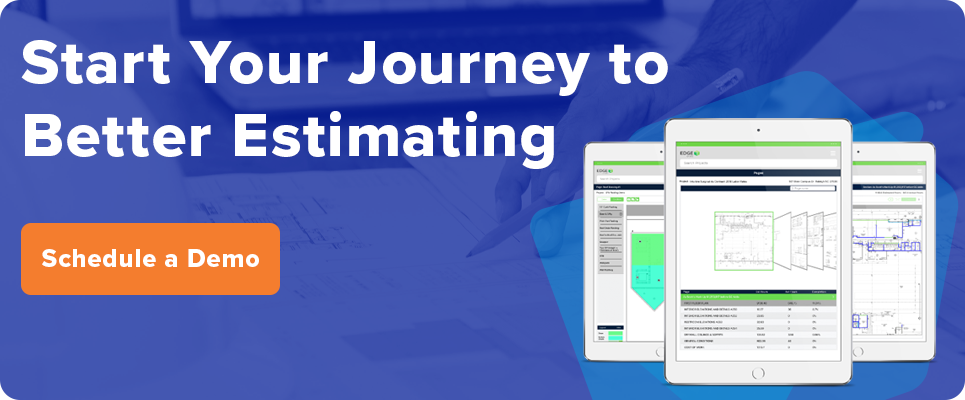
The construction industry is continuously evolving, with new trades and job opportunities emerging as technology, like construction estimating software, advances and market demands shift.
For construction companies looking to expand their horizons, venturing into new trades can provide a competitive edge and enhance revenue streams.
However, expanding into new trades comes with its own set of challenges, especially in terms of estimating.
Contractors must consider labor costs, material costs, indirect costs, and project timelines as they build out their estimates.

If contractors attempt to diversify their trades without taking these estimating factors into consideration, they will be limiting their profits and may face unexpected project delays.
Here, we will explore how construction companies can successfully navigate these new opportunities while emphasizing the importance of accurate construction estimating.
Key Takeaways
- As contractors attempt to expand into new trades, they should research the market(s), schedule training for their employees, and see if they have a crossover with their skill sets and materials to expand into new trades easily.
- Contractors should focus on developing strategies or leveraging software to improve construction estimating as they prepare for new trades.
- Precise construction estimating enables contractors to win more jobs, accurately project future costs and profitability, and maintain compliance with building standards and the expectations of project owners.
- By investing in construction estimating software — like The EDGE® — contractors can leverage real-time data to make more informed decisions as they expand their operations into new trades.
New Opportunities in New Construction Trades
There are several ways for contractors to identify and prepare for new opportunities. These steps involve:
1. Researching the Market(s)
Estimators should identify emerging trends — such as green building or the use of construction software. Understanding the market landscape will help companies prioritize areas of improvement and lead them to develop skills and expertise that will help them attain long-term success.
2. Training and Upskilling Workers
Once potential new trades are identified, companies should invest in training their workforce. This could involve:
- Opportunities for formal education
- Apprenticeships with trade experts
- Partnerships with trade schools
Upskilling existing employees not only enhances the workforce’s capabilities but also boosts morale and loyalty because they feel their employer is invested in their long-term success.
3. Diversifying Services
Consider how current capabilities can be adapted to new trades. For instance, a general contractor could branch into a specialized area like roofing.
Contractors can expand into the roofing trade (or any other trade) by:
- Using roofing subcontractors
- Sending employees to shadow roofers
- Relying on smaller roofing projects at first to practice new skill sets
By leveraging existing resources and client relationships, companies can source trade-specific materials, which, when paired with accurate estimates, can help them win more jobs.
As construction companies create a plan to expand into new trades, it’s important that they have a plan in place to adapt their construction estimating.
Construction Estimating’s Role
As construction companies venture into new trades, accurate estimating practices become essential for sustained success.
Expanding into unfamiliar territory can lead to inaccurate estimates or financial mismanagement if a plan is not in place.
Here’s why creating an effective construction estimating strategy is crucial during this transition:
1. Win More Jobs
While specific details are different across trades and projects, developing an effective estimating and takeoff strategy translates to more project opportunities.
Construction estimating and takeoff provide estimators with accurate material quantities, costs, and timelines for each project’s requirements.
Creating precise estimates helps estimators build better bids and, ultimately, win more jobs within new trades.
2. Improves Cost Management and Profitability
Each new trade will have its own unique costs associated with:
- Materials
- Labor
- Equipment
Accurate construction estimating allows companies to meticulously plan for these expenses and develop accurate budgets, ensuring project goals are met and profitability is maximized.
3. Enhances Project Management
As estimators and their teams take on new trades, it’s important they’re all on the same page to avoid confusion and unnecessary delays and costs.
By building better estimates, estimators provide a project plan that can be followed by the rest of the team. Estimators account for:
- Project costs (labor, materials, equipment costs, etc.)
- Project timelines
- Expected profitability
With each of these in mind, estimators and their teams can follow the information laid out in the estimate to improve project management and performance as they expand into new trades.
The Benefits of Construction Estimating Software
Implementing construction estimating software can significantly streamline the estimating process, reduce errors, and enhance overall efficiency as contractors expand into new trades. Here are some key benefits:
1. Automation of Processes
Construction estimating software automates many repetitive tasks, such as measuring, calculating quantities, cost totals, and labor hours.
This automation not only saves time with the construction process but also minimizes human error, leading to more accurate estimates.
Ensuring estimates are accurate is always important, but particularly when pursuing new trades because it helps less experienced contractors be more competitive as they attempt to win jobs over contractors who are already established within that trade.
2. Real-Time Insights
Advanced software provides real-time insights into construction project costs and profitability.
This allows construction managers to account for and approve change orders as they arise and make data-driven decisions, reducing the risk of financial surprises or delays throughout the project.
3. Trade-Specific Databases
Construction estimating software often offers multiple trade databases. Estimators can add additional trade databases to their system by quickly talking to a representative from the provider.
Many of these databases come pre-loaded with items and assemblies that are specific to each trade, making it easier for contractors to build better bids within new trades.
4. Integration with Construction Accounting Software
Many construction estimating software — like The EDGE — integrate seamlessly with construction accounting software.
This integration helps ensure that financial data aligns with project timelines and milestones, fostering better communication and coordination across teams.

Trust The EDGE to Help You Expand into New Trades
Expanding into new trades presents a range of opportunities for construction companies. However, to ensure success in these new ventures, accurate construction estimates are paramount.
With The EDGE, estimators can:
- Automate estimating and takeoff
- Reduce errors and easily communicate change orders
- Give estimators access to a range of trade-specific databases to build more precise estimates
- Win more bids, improve project productivity, and maximize profitability
By leveraging The EDGE, estimators can ensure their operations are prepared as they expand into new trades.
To learn more about how The EDGE can help your construction estimating, click here to talk to one of our construction professionals.






